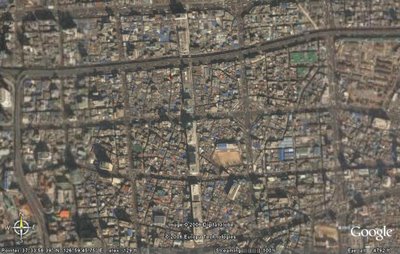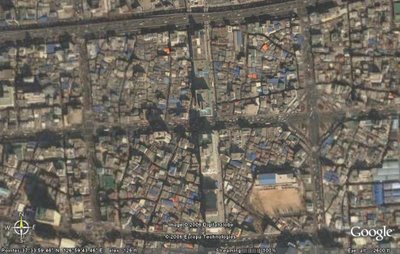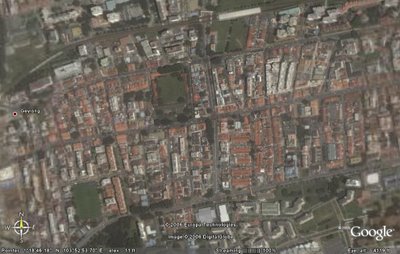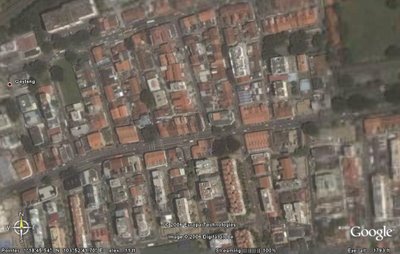Framing Order in Disorder

Cheonggyecheon, Seoul, S. Korea
As I think of the example of using framing to impose an order upon something in disorder, I'm reminded of this aerial photo of Cheonggyecheon, Seoul, S. Korea. The orthogonal roads have framed each parcel of land, where within the parcel exists many little houses, businesses packed in a tightly-knit organic fashion. Such a phenomenon is not uncommon in old cities. Is this then the example in framing of disorder, viewed from the aerial perspective of the city? Certainly, this is not the only way of understanding or experiencing our city. Are there other ways or perspectives of viewing our city which reveal order in disorder?
 Cheonggyecheon, Seoul, S. Korea - closer view
Cheonggyecheon, Seoul, S. Korea - closer view
 Geylang, Singapore
Geylang, Singapore
In contrast, the aerial photo of Geylang, Singapore, reveals strict ordering principles throughout the parcels of land.
 Geylang, Singapore - closer view
Geylang, Singapore - closer view
(Aerial photos obtained through Google Earth.)

3 Comments:
Having been to both sites that you had posted, i think i just want to comment on something.
Cheongyecheon has a very unique character that overwhelms anyone who turns a little corner into the organic spatial order of the traditional area [which had resulted from a close relationship to the streams before]. on the other hand, geylang also has a very unique character once u turn into the lorongs [and perhaps the most famous lor 18] where houses of "fish tanks" architecture speaks for themselves.
If one were to compare both, one entails a very strong architectural [tangible and physical] character that has its origins in history and the other is more strongly expressed through its programs of the place despite a seemingly ordered planning. Yet both have uniqueness in their character.
perhaps cheongyecheon's disorder comes from an intrinsic order of a close attachment to its environment of the past. whereas geylang's disorder comes from an intrinsic order of a close attachment to its program. be it the program or its environment. both are equally framed and expressed in architecture, be it the organic streetscapes of cheongyecheon or the transparent fish tank boxes of geylang.
Indeed, the physical architecture as well as the program play a part in creating a climate of disorder. To take this discussion a step further, I would like to introduce the factor of timing.
In our studio discussions, we have talked abt how we can frame a pile of rubbish by composing in a photograph, thus introducing order.
In the cheonggyecheon example, the organic pattern of dwellings arose in relation to its environment since history. The orthogonal roads came about later to facilitate vehicular movement through this city centre. In this way, I see this process analogous to the framing of rubbish through taking photo.
On the other hand, the geylang situation was planned orderly. The spaces within this strict order were then occupied by the programs that generated the disorder. And perhaps the physical order was too strict to break, the disorder occured at the programmatic level and also at a more micro, manipulative scale.
Perhaps this can activate weixiong's discussion on "do we desire chaos?" Since the chaos that has been discussed thus far strictly revolved around physical, tangible aspects, do we then talk about chaos in program? Do we design physical disorder? Or can we design programmatic disorder? Or can these processes be so delibrate? After all, besides delibrate, there are also accidents.
i see two main threads of concern in this question of "do we desire chaos?" first and foremost, i think it is important to understand the concept of chaos. supposedly there exists two elements of chaos: chaos as its true character being autonomous from order of any form; chaos as perceived chaos by the human.
the first form of chaos perhaps is identified by the 'chaos theory'. the scientific identification of how even mathematical numbers cannot be certain. it is the second form of chaos 'perception by human' that i think is worth an in depth study upon on and what i think is a closer link to the discourse of architecture.
our perception of chaos is very much influenced by our cultural environment and many other factors that shaped our thinking. the industrialised mentality of efficiency and straight lines had more or less generated the appreciation of the 'box architecture' order. coupled with the forces of international movement, we had been tuned to clean lines as we regenerate new forms ourselves. this is evident even in the masterplanning [the ever frequent cited example of new york's grid].
in cheongyecheon, the 'untidy' organic roads being framed by the cleaner efficient wider roads of the grid superimposed upon in fact shows two orders. one that reflects an order that is appreciated before industrailisation and one that is appreciated after. the question to come will be, "wat is the order appreciated in our era now?" there seems to be a growing trend in orders inspired from the nature. be it fractal forms, or toyo ito's caves and trees structure. is that the new appreciated order of now then?
in a tropical rainforest, it is on the surface highly chaotic, all the different species of plants growing at random. but we also know that there are hierarchy of orders underlying the seemingly chaotic rainforest. the thick undergrowth, the primary forest, the high trees. they all work together to maintain the ecosystem of the rainforest. is that chaos? or is it more of an order that is beyond human's capacity to appreciate and to understand?
back to whether we desire chaos or not. i think we need to answer our own perception of wat is chaos. before we can say we appreciate this ancient order of beauty.
Post a Comment
<< Home